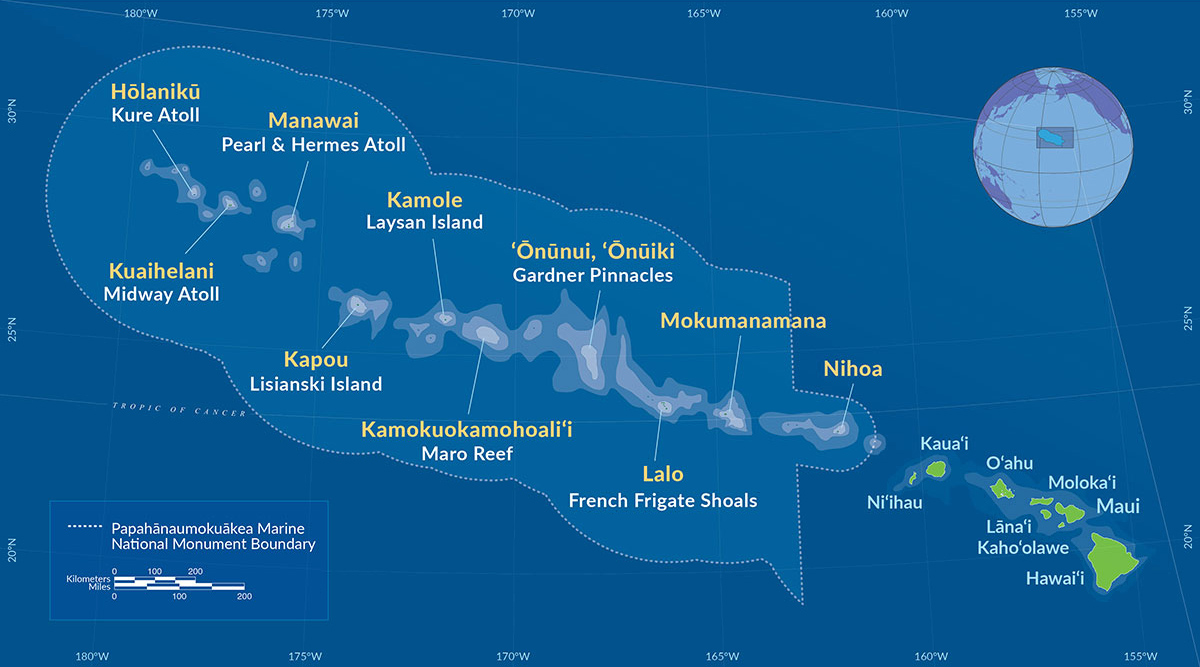News and Announcements
Press Release – Western Pacific Council and Northwestern Hawaiian Islands Managers Collaborate to Draft Management Plan (25 June 2021)
 HONOLULU (25 June 2021) The Western Pacific Regional Fishery Management Council and managers of the Papahānaumokuākea Marine National Monument (PMNM) agreed to work together yesterday at a meeting in Honolulu to develop a draft management plan ahead of the formal sanctuary proposal process scheduled to start this fall. In December 2020, President Trump signed a funding bill that would strengthen protections for the monument by designating it as a national marine sanctuary.
HONOLULU (25 June 2021) The Western Pacific Regional Fishery Management Council and managers of the Papahānaumokuākea Marine National Monument (PMNM) agreed to work together yesterday at a meeting in Honolulu to develop a draft management plan ahead of the formal sanctuary proposal process scheduled to start this fall. In December 2020, President Trump signed a funding bill that would strengthen protections for the monument by designating it as a national marine sanctuary.
While the PMNM, and its subsequent expansion, was established via presidential proclamation, the sanctuary proposal process is a bottoms-up approach to management similar to the Magnuson-Stevens Act, and would give the Council “a seat at the table” to propose regulations for the entire area.
“After the 2016 expansion allowing recreational and subsistence fishing, we engaged with fishermen and native Hawaiian communities about fishing in the expanded area,” said Council Executive Director Kitty Simonds. “We had sessions about customary exchange, but didn’t get much traction.” This is allowed in the Marianas Trench and Rose Atoll Marine National Monuments.
The Council will collaborate with NOAA to prioritize issues and develop potential management actions for the proposed sanctuary, keeping in mind the sideboards of the original monument proclamation, such as the prohibition of commercial fishing.
Bigeye Tuna Catch Limits
The Council recommended setting a bigeye tuna longline catch limit of 2,000 metric tons (4.4 million pounds) for each of the U.S. Participating Territories of American Samoa, Guam and the Commonwealth of the Northern Mariana Islands. A limit of 1,500 metric tons (3.3 million pounds) per territory, up to 3,000 metric tons total, may be transferred to U.S. vessels as permitted through specified fishing agreements. Monies from these agreements, approved by the U.S. Secretary of Commerce, go into the Western Pacific Sustainable Fisheries Fund and are used to implement projects in each territory’s marine conservation plan.
A 2020 assessment for the Western and Central Pacific Ocean (WCPO) bigeye tuna says the stock is healthy—not subject to overfishing or overfished.
For 2023 to 2026, the Council supported not setting a bigeye tuna catch limit for the U.S. Participating Territories, and allowing each region to transfer up to 1,500 metric tons (4,500 metric tons total) to U.S. permitted vessels. This recognizes that a new Western and Central Pacific Fisheries Commission conservation and management measure for tropical tunas is likely beginning in 2022, and stock assessments for WCPO bigeye tuna are expected in 2023 and 2026.
Main Hawaiian Islands Deep 7 Bottomfish Catch Limits
The Council recommended that NOAA implement the 492,000-pound annual catch limit with an in-season accountability measure for fishing years 2021-22, 2022-23 and 2023-24. According to a 2022 assessment, the stock is healthy—not overfished and no overfishing is occurring. It is estimated at 22 million pounds, nearly 2 million more pounds than the last assessment done in 2018.
Presidential Executive Orders
NOAA Deputy Assistant Administrator for Regulatory Programs Sam Rauch summarized the multi-agency Conserving and Restoring America the Beautiful report that provides recommendations on how the United States should achieve the goal of conserving at least 30% of waters by 2030. The report resulted from President Biden’s Executive Order (EO) 14008 on Tackling the Climate Crisis at Home and Abroad.
Rauch posed several key questions for future engagement, including an evaluation of currently effective conservation actions and areas that meet the conservation criteria, among others. While the initiatives described in the report are not new, he emphasized the critical role of the regional fishery management councils in reaching the goals of the president, and noted it was a recognition justly earned for work done over the years.
Regarding the president’s EO 13985 and EO 14031 on advancing racial equality and underserved communities, the Council agreed to inform the Biden Administration of the barriers to providing equity, justice and opportunity to those in the Western Pacific Region. More than 75% of the region’s population identifies as indigenous, Asian American, Pacific Islander or other persons of color—all groups that fall under the EO’s definition of underserved communities that have historically been denied equitable treatment.
For years, Council leadership has reminded Administrations that “we are not asking for more, we are asking for different” to effectively support our Pacific communities.
The Council heard a presentation on EO 13985 that described equity barriers such as limited capacity, communication differences, available funding opportunities, regional representation and rigid national policies, among others. Members were reminded of Council-supported initiatives, like fishery development projects and territorial scholarships, aimed at addressing economic, social and educational disparities in the region.
“A perfect example of this is Guam fishermen’s applications for the CARES Act economic relief funds,” noted Michael Dueñas, Council member from Guam. “Initially, only 270 fishers applied due to lack of access to technology and language barriers. After extensive outreach, that number increased to 468.”
For meeting agenda and briefing materials, visit www.wpcouncil.org/meetings-calendars.
